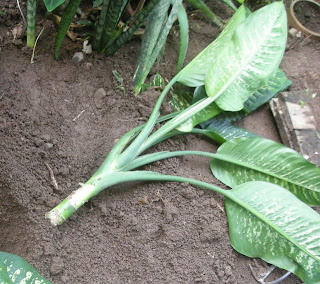 Some tropical plants would take over the world if allowed − at least the tropical world. Every few months we hire a couple of guys to cut back and clean up some of the overgrown plants. I don't mean pruning. I do that because I don't want anyone taking a machete to my plants. I'm talking about hacking back into their allowed space, cutting them off at the ground, and/or digging them up by the roots.
Some tropical plants would take over the world if allowed − at least the tropical world. Every few months we hire a couple of guys to cut back and clean up some of the overgrown plants. I don't mean pruning. I do that because I don't want anyone taking a machete to my plants. I'm talking about hacking back into their allowed space, cutting them off at the ground, and/or digging them up by the roots. We have no end of compost materials. Between the mountains of trimmings and the wood shavings that a carpenter brings to us, we always have huge compost piles going. But over the years, we've found that some plants will just continue to grow in the compost.
Elephant ears, costus, and Dieffenbachia maculata are unstoppable.
 When these Dieffenbachia get leggy, I just dig them up, cut off the leafy tops and plant those in the jardinera (planter box). Water them in and they are good to go.
When these Dieffenbachia get leggy, I just dig them up, cut off the leafy tops and plant those in the jardinera (planter box). Water them in and they are good to go.This last time, I had so many that I thought I would plant a few around the garden, too. The decapitated tops sat in pots and buckets (with no soil) in the heat for a week or two before I got around to planting some of them.
 The rest remained in this bucket with no soil or water for another month before I finally threw them out. They were still alive! The leaves were barely yellow and hardly wilted.
The rest remained in this bucket with no soil or water for another month before I finally threw them out. They were still alive! The leaves were barely yellow and hardly wilted.We originally tried composting the discarded stems and plants and they just grew in the compost. We tried chopping them up with a machete and throwing the remains in the compost. They still grew. We tried setting them aside to dry up in the sun and they still grew.
 The workers, explicitly against what we had told them, began throwing them in the jungle area behind our property. Very bad! Of course, they grew and some, especially the elephant ears, are becoming invasive.
The workers, explicitly against what we had told them, began throwing them in the jungle area behind our property. Very bad! Of course, they grew and some, especially the elephant ears, are becoming invasive. Last summer, I was able to get the workers to toss the stems in the side street on the concrete in the hot sun, thinking that the stems would shrivel up and then we could compost them.
Last summer, I was able to get the workers to toss the stems in the side street on the concrete in the hot sun, thinking that the stems would shrivel up and then we could compost them. The workers had very stern warnings not to throw anything in the wild area. They thought that was completely crazy, as well as unnecessary since it is much tidier to throw the discards down by the creek where they will no longer be our problem.
The workers had very stern warnings not to throw anything in the wild area. They thought that was completely crazy, as well as unnecessary since it is much tidier to throw the discards down by the creek where they will no longer be our problem. This photo shows the result of trying to fry them in the street. Even after months of the hot dry season, they grew in the leaf rubble that blew down the street. The concrete is so hot that it would burn your feet if you tried to walk barefoot, but no problem for these plants. The recent photo show them thriving on the concrete after a few months of rainy season.
This photo shows the result of trying to fry them in the street. Even after months of the hot dry season, they grew in the leaf rubble that blew down the street. The concrete is so hot that it would burn your feet if you tried to walk barefoot, but no problem for these plants. The recent photo show them thriving on the concrete after a few months of rainy season.Now what? Pile them up and have a bonfire?



 Welcome to my Blogicito —
Welcome to my Blogicito — 







